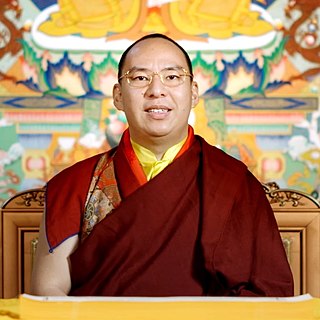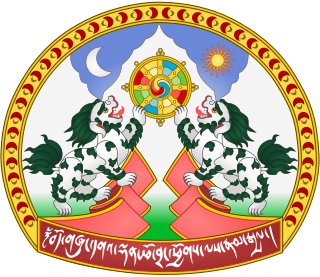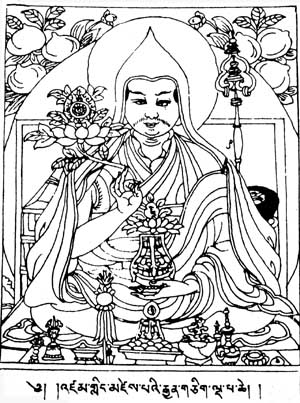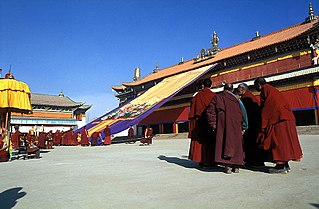Related Research Articles

Dalai Lama is a title given by the Tibetan people to the foremost spiritual leader of the Gelug or "Yellow Hat" school of Tibetan Buddhism, the newest and most dominant of the four major schools of Tibetan Buddhism. The 14th and current Dalai Lama is Tenzin Gyatso, who lives as a refugee in India. The Dalai Lama is also considered to be the successor in a line of tulkus who are believed to be incarnations of Avalokiteśvara, the Bodhisattva of Compassion.

Tibet is a region in East Asia, covering much of the Tibetan Plateau and spanning about 2,500,000 km2 (970,000 sq mi). It is the traditional homeland of the Tibetan people. Also resident on the plateau are some other ethnic groups such as Monpa, Tamang, Qiang, Sherpa and Lhoba peoples and now also considerable numbers of Han Chinese and Hui settlers. Since 1951, the entire plateau has been under the administration of the People's Republic of China, a major portion in the Tibet Autonomous Region, and other portions in the Qinghai and Sichuan provinces.

The Central Tibetan Administration, often referred to as the Tibetan Government-in-Exile, is a non-profit political organization based in Dharamshala, India. Its organization is modeled after an elective parliamentary government, composed of a judiciary branch, a legislative branch, and an executive branch.

The Panchen Lama is a tulku of the Gelug school of Tibetan Buddhism. Panchen Lama is one of the most important figures in the Gelug tradition, with its spiritual authority second only to Dalai Lama. Along with the council of high lamas, he is in charge of seeking out the next Dalai Lama. Panchen is a portmanteau of Pandita and Chenpo, meaning "great scholar".

Chökyi Gyalpo, also referred to by his secular name Gyaincain Norbu or Gyaltsen Norbu, is considered the 11th Panchen Lama by the government of the People's Republic of China (PRC). He is also the vice president of the Buddhist Association of China. Gyalpo is considered by some to be a proxy of the Chinese government.
Tibet is a region in East Asia covering much of the Tibetan Plateau that is currently administered by People's Republic of China as the Tibet Autonomous Region and claimed by the Republic of China as the Tibet Area and the Central Tibetan Administration. The CTA uses the snow lion flag of the independent Tibetan state from 1912 to 1951. The snow lion flag has become a pro-independence symbol and is outlawed in the People's Republic of China after the 1959 Tibetan uprising. The PRC uses its national flag instead to represent Tibet.

Lobsang Trinley Lhündrub Chökyi Gyaltsen was the tenth Panchen Lama, officially the 10th Panchen Erdeni, of the Gelug school of Tibetan Buddhism. According to Tibetan Buddhism, Panchen Lamas are living emanations of the buddha Amitabha. He was often referred to simply as Choekyi Gyaltsen.
Tibetan Americans are Americans of Tibetan ancestry. As of 2020, more than 26,700 Americans are estimated to have Tibetan ancestry. The majority of Tibetan Americans reside in Queens, New York.
The Tibetan sovereignty debate refers to two political debates. The first political debate is about whether or not the various territories which are within the People's Republic of China (PRC) that are claimed as political Tibet should separate themselves from China and become a new sovereign state. Many of the points in this political debate rest on the points which are within the second historical debate, about whether Tibet was independent or subordinate to China during certain periods of its recent history.

Ngapoi Ngawang Jigme was a Tibetan senior official who assumed various military and political responsibilities both before and after 1951 in Tibet. He is often known simply as Ngapo in English sources.

The 1959 Tibetan uprising began on 10 March 1959, when a revolt erupted in Lhasa, the capital of Tibet, which had been under the effective control of the People's Republic of China since the Seventeen Point Agreement was reached in 1951. The initial uprising occurred amid general Chinese-Tibetan tensions and a context of confusion, because Tibetan protesters feared that the Chinese government might arrest the 14th Dalai Lama. The protests were also fueled by anti-Chinese sentiment and separatism. At first, the uprising mostly consisted of peaceful protests, but clashes quickly erupted and the Chinese People's Liberation Army (PLA) eventually used force to quell the protests, some of the protesters had captured arms. The last stages of the uprising included heavy fighting, with high civilian and military losses. The 14th Dalai Lama escaped from Lhasa, while the city was fully retaken by Chinese security forces on 23 March 1959. Thousands of Tibetans were killed during the 1959 uprising, but the exact number of deaths is disputed.

The 2008 Tibetan unrest, also referred to as the 2008 Tibetan uprising in Tibetan media, was a series of protests and demonstrations over the Chinese government's treatment and persecution of Tibetans. Protests in Lhasa, the capital of Tibet, by monks and nuns on 10 March have been viewed as the start of the demonstrations. Numerous peaceful protests and demonstrations were held to commemorate the 49th anniversary of the 1959 Tibetan Uprising Day, when the 14th Dalai Lama escaped from Tibet. The protests and demonstrations spread spontaneously to a number of monasteries and throughout the Tibetan plateau, including into counties located outside the designated Tibet Autonomous Region. The arrest of monks at Labrang Monastery increased the tension of the situation. Violence began when Chinese police and People's Liberation Army units used force on non-violent protests by monks and nuns, and spread when protesting Tibetans later clashed with security forces. Clashes also occurred between Tibetans and Chinese Han and Hui residents, resulting in Han and Hui stores and buildings being destroyed and numerous Chinese civilians being injured or killed.

The Tibetan Parliament in Exile (TPiE), officially the Parliament of the Central Tibetan Administration, is the unicameral and highest legislative organ of the Central Tibetan Administration, the government-in-exile of the Tibet Autonomous Region of China. It was established and is based in Dharamshala, India. The creation of this democratically elected body has been one of the major changes that the 14th Dalai Lama brought about in his efforts to introduce a democratic system of administration.

The 14th Dalai Lama, known as Gyalwa Rinpoche to the Tibetan people, is the current Dalai Lama. He is the highest spiritual leader and former head of the country of Tibet. He was born on 6 July 1935, or in the Tibetan calendar, in the Wood-Pig Year, 5th month, 5th day. He is considered a living Bodhisattva, specifically, an emanation of Avalokiteśvara in Sanskrit and Chenrezig in Tibetan. He is also the leader and a monk of the Gelug school, the newest school of Tibetan Buddhism, formally headed by the Ganden Tripa. The central government of Tibet, the Ganden Phodrang, invested the Dalai Lama with temporal duties until his exile in 1959.
Serfs' Emancipation Day, observed annually on 28 March, is a holiday in the Tibet Autonomous Region of China that celebrates the emancipation of serfs in Tibet. The holiday was adopted by the Tibetan legislature on 19 January 2009, and was promulgated that same year. In modern Tibetan history, 28 March 1959 was the day that the Tibetan government was declared illegal by China and replaced with the Preparatory Committee for the Tibet Autonomous Region (PCTAR), with the Panchen Lama replacing the Dalai-Lama as its acting chairman. This effectively marked an end to serfdom and the abolition of the hierarchic social system characterized by theocracy.

The Dual System of Government is the traditional diarchal political system of Tibetan peoples whereby the Desi coexists with the spiritual authority of the realm, usually unified under a third single ruler. The actual distribution of power between institutions varied over time and location. The Tibetan term Cho-sid-nyi literally means "both Dharma and temporal," but may also be translated as "dual system of religion and politics."

Kirti Gompa, is a Tibetan Buddhist monastery founded in 1472 and located in Ngawa, Sichuan province, in China, but traditionally part of Amdo region. Numerous other associated Kirti monasteries and nunneries are located nearby. As of March 2011, the Kirti Gompa was said to house 2,500 monks. Between 2008 and 2011, mass arrests and patriotic re-education programs by Chinese authorities have targeted the monks, reducing the population substantially to 600 monks. The wave of Tibetan self-immolations began at Kirti Gompa.

Protests and uprisings in Tibet against the government of the People's Republic of China have occurred since 1950, and include the 1959 uprising, the 2008 uprising, and the subsequent self-immolation protests.

As of May 2022, 160 monks, nuns, and ordinary people have self-immolated in Tibet since 27 February 2009, when Tapey, a young monk from Kirti Monastery, set himself on fire in the marketplace in Ngawa City, Ngawa County, Sichuan. According to the International Campaign for Tibet (ICT), "Chinese police have beaten, shot, isolated, and disappeared self-immolators who survived."

Antireligious campaigns in China refer to the Chinese Communist Party's official promotion of state atheism, coupled with its persecution of people with spiritual or religious beliefs, in the People's Republic of China. Antireligious campaigns were launched in 1949, after the Chinese Communist Revolution, and they continue to be waged against Buddhists, Christians, Muslims, and members of other religious communities in the 21st century. State campaigns against religion have escalated since Xi Jinping became General Secretary of the Chinese Communist Party on November 15, 2012. For Christians, government decrees have mandated the widespread removal of crosses from churches, and in some cases, they have also mandated the destruction of houses of worship, such as the Catholic Three Rivers Church in the city of Wenzhou. In Tibet, similar decrees have mandated the destruction of Tibetan Buddhist monastic centers, the destruction of sacred Buddhist sites, the destruction of monastic residences, the denial of the Tibetan people's right to freely access their cultural heritage, the ongoing persecution of high Buddhist lamas and the ongoing persecution of Buddhist nuns and monks. Reports which document the existence of forced re-education camps, arrests, beatings, rape, and the destruction of religious sites in Tibet are also being published with regard to the Uyghur people, who are being subjected to an ongoing genocide.
References
- ↑ Staff. "達賴喇嘛西藏宗教基金會: About Foundation". Tibet Religious Foundation of H.H. The Dalai Lama. Retrieved 4 February 2010.(in English)
- ↑ Dalai Lama opens representative office in Taiwan, AFP, April 16, 1998
- ↑ "NGAWA TSEGYAM". Tibetanwhoswho.wordpress.com. 31 May 2011. Retrieved 29 October 2018.
- ↑ "Taiwan Headlines: Foundation leader calls for candidates to speak for Tibet". Government Information Office, Republic of China (Taiwan). 18 March 2008. Archived from the original on 22 December 2012. Retrieved 4 February 2010. Source: Taiwan News.